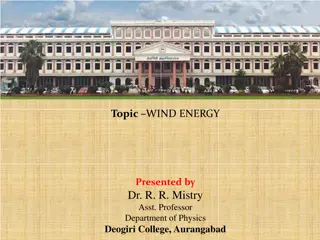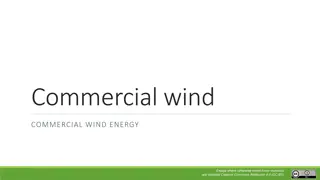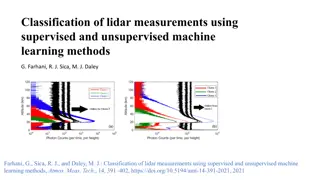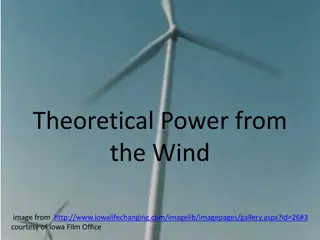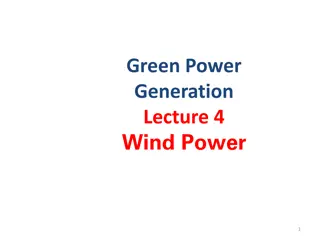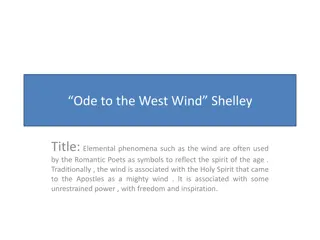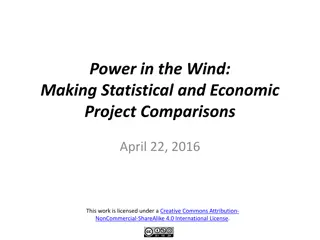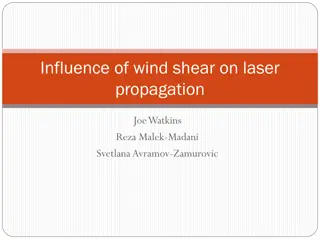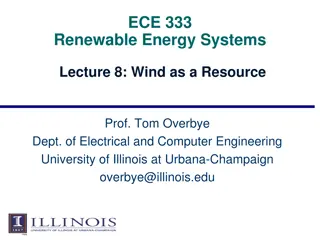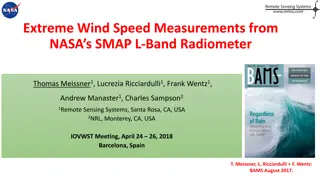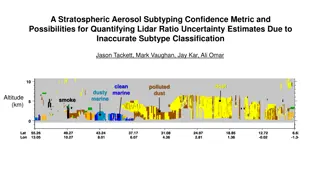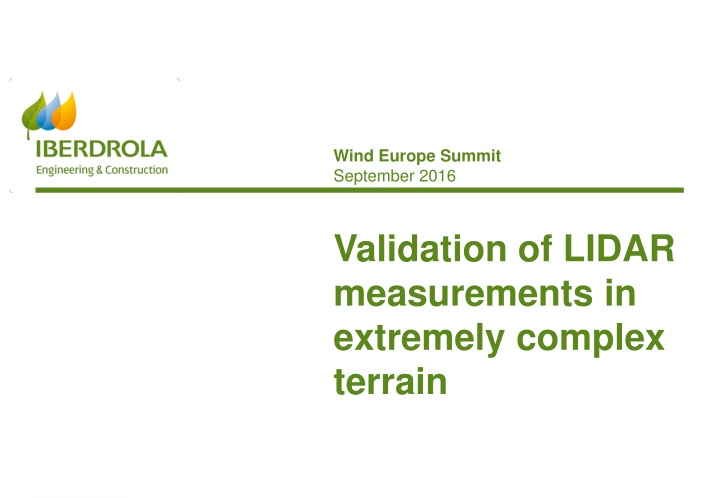
Validation of LIDAR Measurements in Complex Terrain - Wind Europe Summit
Validation of LIDAR measurements in extremely complex terrain was conducted at the Wind Europe Summit in September 2016. The study focused on analyzing the use of ground-based continuous wave LIDAR in challenging sites, comparing wind speed and turbulence intensity measurements with nearby met masts. The research considered factors such as data availability, mean wind speed, maximum wind speed distribution, and turbulence intensity in a specific Spanish site with varied altitudes and slopes. The study also addressed the use of CFD models to analyze non-uniform flow patterns and parameterize models appropriately for accurate measurements in complex terrains.
Download Presentation

Please find below an Image/Link to download the presentation.
The content on the website is provided AS IS for your information and personal use only. It may not be sold, licensed, or shared on other websites without obtaining consent from the author. If you encounter any issues during the download, it is possible that the publisher has removed the file from their server.
You are allowed to download the files provided on this website for personal or commercial use, subject to the condition that they are used lawfully. All files are the property of their respective owners.
The content on the website is provided AS IS for your information and personal use only. It may not be sold, licensed, or shared on other websites without obtaining consent from the author.
E N D
Presentation Transcript
Wind Europe Summit September 2016 Validation of LIDAR measurements in extremely complex terrain 1 www.iberdrolaingenieria.com
Validation of LIDAR measurements in extremely complex terrain 1. 2. 3. 4. 5. 6. Introduction Complex terrain, LIDAR and CFD models Model parametrization and results Results I: Data availability Results II: Wind Speed (Mean) Results III: Wind Speed (Maximum and distribution) Results IV: Turbulence intensity Conclusions 7. 8. 2 www.iberdrolaingenieria.com
1. Introduction 3 www.iberdrolaingenieria.com
1. Introduction An overview To analyze the use of ground base continuous wave LIDAR (Zephir 300) in very complex sites. AIM Comparison mean wind speed or turbulence intensity measured in the LIDAR and in a nearby met mast. of variables as METHOD Extremely complex Spanish site with a mean altitude of 1,100 m and slopes of 30 near the LIDAR device. SITE 4 www.iberdrolaingenieria.com
1. Introduction Wind farm for testing (Cantabria, North Spain) LIDAR and meteorological mast Slopes at site in degrees. Projected WTGs (blue points) and LIDAR position (green cross) Relative position of LIDAR and met mast 5 www.iberdrolaingenieria.com
2. Complex terrain, LIDAR and CFD models 6 www.iberdrolaingenieria.com
2. Complex terrain, LIDAR and CFD models SOLUTION PROBLEMATIC Non uniform flow across the LIDAR scan cone Analysis with a CFD model Breakdown of the model assumptions Different measurements of LIDAR and CUPS Meteodyn CFD (version 5.0.3) Error depends on the curvature of the flow 7 www.iberdrolaingenieria.com
3. Model parametrization and results 8 www.iberdrolaingenieria.com
3. Model parametrization and results Sharp topography in main directions needs a precise CFD model parametrization. Dynamics factors sector (10 ) for each LIDAR measurement height. correction wind direction by Wind rose measured at site (green) and slopes at a 50 m radius from LIDAR position (orange) Directional correction factors at different heights (36 sectors from 20 to 200m) 9 www.iberdrolaingenieria.com
4. Results I: Data availability 10 www.iberdrolaingenieria.com
4. Results I: Data availability Low aerosol presence at high altitudes and climatic conditions (fog and others). Data availability (filtered by LIDAR s internal processor) showed a decrease with height. unfavorable significant LIDAR data filtered by adverse atmospheric conditions (green) and by low quality of measurements (orange) Evolution of LIDAR (blue) and CUP (red) wind data availability with height 11 www.iberdrolaingenieria.com
5. Results II: Wind Speed (Mean) 12 www.iberdrolaingenieria.com
5. Results II: Wind Speed (Mean) After CFD mean WS at 45 m hub height showed a BIAS of 0.6%. applying correction calculated factors, Only considered for the analysis. WS > 2m/s were BIAS almost calculated CFD correction factors. was 10% reduced using in the WSlidar= slope WScup + offset Wind speed range at 45 m BIAS (%) Data R2 Slope Offset WScup > 2 m/s 0.9953 0.9541 0.4395 17349 -0.6 LIDAR against CUP wind speeds both measured at 45m level 13 www.iberdrolaingenieria.com
6. Results III: Wind Speed (Maximum and distribution) 14 www.iberdrolaingenieria.com
6. Results III: Wind Speed (Maximum and distribution) Max. WS values were not correctly reproduced by LIDAR device with LIDAR max. WS values 4m/s below the ones registered by CUPs. LIDAR and CUP WS distribution presented considerable differences in significant wind speed bins. 15 www.iberdrolaingenieria.com
7. Results IV: Turbulence intensity 16 www.iberdrolaingenieria.com
Results IV: Turbulence intensity results Directional measurements: characterized separately. analysis in order and to validate LIDAR TI northern southern directions were Common concurrent period WScup > 2m/s TIlidar= slope TIcup + offset BIAS (%) Dir range at 45 m Data R2 Slope Offset Dircup 43.5m 315-45 0.5316 0.6394 7.9897 6488 13.8 Dircup 43.5m 135-225 0.8236 0.8184 2.6049 10063 5.5 Correlation of LIDAR and CUP turbulence intensity considering southern directions (135- 225 ). Correlation of LIDAR and CUP turbulence intensity considering northern directions (315- 45 ). 17 www.iberdrolaingenieria.com
Results IV: Turbulence intensity results However deviations in TI global mean values were high. TI analysis by wind speed bins showed differences that could be crucial for site assessment purposes. 18 www.iberdrolaingenieria.com
8. Conclusions 19 www.iberdrolaingenieria.com
8. Conclusions At an extremely complex site A correct set of dynamic correction factors can reduced mean WS BIAS in an almost 10% Significant decrease in LIDAR data availability with height Variables as TI shall be analyzed directionally Significant deviations of Site Assessment variables as TI and Max. WS Non uniform flow along the LIDAR scan cone Low aerosol presence at such altitude and unfavorable climatic conditions at site (fog and others) Directional behaviour Focus on Site Assessment 20 www.iberdrolaingenieria.com
Iberdrola Engineering Wind Resource Department September 2015 For more information: sssl@iberdrola.es 21 www.iberdrolaingenieria.com

